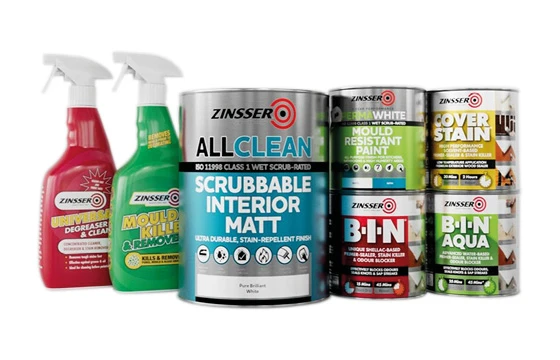How to paint chalky / friable exterior walls
Chalky exterior walls are a common problem. Over time, paint can begin to break down and form a powdery residue known as “chalking,” which affects the finish and adhesion of any new coats.
So, what do you do if paint is chalking? Understanding how to fix chalky walls is essential when restoring your home’s exterior and preventing further deterioration. With Zinsser, you can effectively prepare and prime chalky surfaces, ensuring a durable, long-lasting result. In this guide, we’ll show you how to address chalking walls and get your exterior back in top condition.

What you will need:

Required Steps
All surfaces must be clean, dry and free from anything that will interfere with the adhesion of the materials to be applied. Remove loose material by scraping or brushing with a stiff bristle brush to a sound edge. Prior to painting, the moisture content should not exceed 12%. Remove all visible signs of organic growth and treat the areas with a proprietary mould killer and remover in accordance with manufacturer’s instructions. Fill any cracks and small surface defects with a suitable filler in accordance with the manufacturer’s instructions. Allow to dry. Rub down with a fine grade abrasive paper. Remove all dust.
Seal all bare and filled areas with Peel Stop® in accordance with the manufacturer’s instructions. Allow a minimum drying time of 2 hours in normal drying conditions.
Decorate with two full coats of AllCoat® Exterior Water-Based Matt, Satin or Gloss or, for low temperatures, use AllCoat Exterior Solvent-Based Satin or Gloss in accordance with the manufacturer’s instructions and drying times.
FAQs
Paint chalking happens when paint is exposed to sunlight, heat and moisture over time. This causes the paint’s surface to degrade, leaving a powdery or chalky residue on the surface.
Yes, but you must use the correct products. You can paint exteriors in winter using Zinsser AllWeather, as it can be applied in temperatures as low as -5°C.
You do not need to use a primer when painting exterior walls with Zinsser AllWeather or AllCoat Exterior, as both products are self-priming. However, for problem surfaces, we would recommend priming first with Bulls Eye 1-2-3.
Sign Up To Our Newsletter
Be the first to receive exclusive news, expert advice, competition details and more. Stay up to date with Zinsser and sign up to receive our email newsletter.
Contact
Computershare Governance Services
The Pavilions
Bridgwater Road
Bristol
BS13 8FD
Company number: 04503854
Tor Coatings Ltd
21 White Rose Way
Follingsby Park
Gateshead
Tyne & Wear
NE10 8YX
